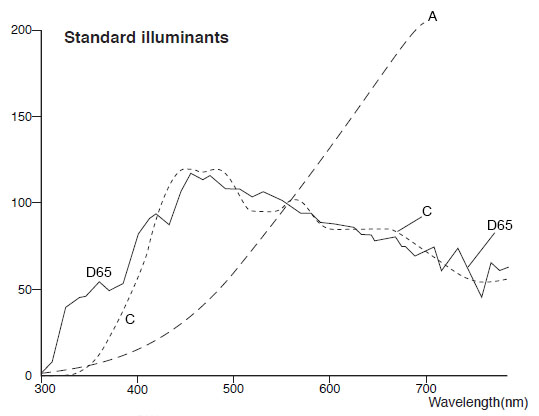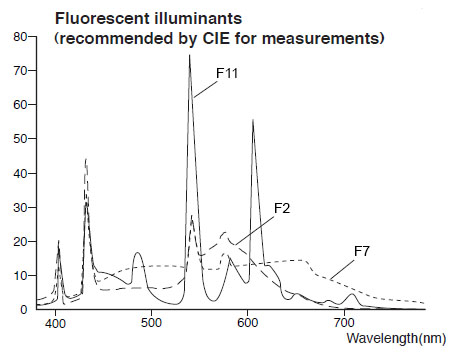Understanding Standard Illuminants in Color Measurement
Light Source vs. Illuminant
A light source can be defined as an object that emits light, such as the light in an office building. Forming its spectral power distribution curve, a light emits different amounts of energy at each wavelength of the visible color spectrum. The strength and distribution of this emitted energy vary for each individual type of light. Daylight, for example, emits light at each wavelength of the spectrum, peaking in the blue region around 460nm. This tells us that daylight is composed mostly of blue light. To quantify an object’s color using a standardized method, a standard spectral power distribution curve must be included in the calculation.
Unlike a light source, an illuminant is not a physical object but rather a representation of a light’s spectral power distribution curve in graph or numerical form (see Figures 1 and 2). CIE, a non-profit organization considered to be the authority on the science of light and color, has defined several illuminants to represent certain light sources, as shown below. The spectral data for these illuminants are stored in color measurement instruments to calculate the color of a sample as it would appear under each light.
Standard Illuminant D65: Average daylight (including ultraviolet wavelength region) with a correlated color temperature of 6504K
Standard Illuminant C: Average daylight (not including ultraviolet wavelength region) with a correlated color temperature of 6774K
Standard Illuminant A: Incandescent light with a correlated color temperature of 2856K

Figure 1
Fluorescent Illuminant F2: Cool white
Fluorescent Illuminant F7: Daylight
Fluorescent Illuminant F11: Three narrow band cool white
Figure 2
Identifying Metamerism Using Illuminants
Metamerism describes a pair of objects that match in color under one lighting condition but not under another. Companies in the textile, paint, automotive, plastics, packaging, and print industries may be affected by this because pigments are sometimes changed when manufacturing or producing different parts of one product, leading to mismatched colors. A section of a car, for example, maybe painted with a color that appears to match the rest of the vehicle when viewed in daylight, but it doesn’t match when viewed under parking lot lighting at night.
To identify metamerism, visual and instrumental tests should be performed to evaluate the samples under two or more different light sources and illuminants, such as daylight (Standard Illuminant D65) and incandescent light (Standard Illuminant A). In the instrumental test, a spectrophotometer allows users to see the reflectance data of the two colors under each illuminant. If metameric properties are identified, corrective action can then be taken to refine the process for future color batches or pigments.
How to Choose Which Illuminant to Use
When choosing which illuminant to use when measuring or evaluating a sample’s color, its end use or where it will be sold should be considered. A fluorescent illuminant may be chosen if the product is sold in a supermarket or department store, for example. This illuminant should be used as the standard for all future visual and instrumental evaluations to maintain color consistency, accuracy, and efficiency throughout your operations.
Like this article? Click here to sign up for our monthly Color Trends & Technology newsletter to stay updated on the element of color, best practices for controlling and evaluating the color of objects, educational seminars, and advanced technology for research and manufacturing environments.
The technological leader in color and light measurement solutions, Konica Minolta Sensing Americas helps organizations formulate, evaluate, and control color to meet product quality and operational goals more efficiently.












